3 Ways a Media Audit Can Drive PR Budgets

Protecting and growing public relations budgets is a top priority for department directors and managers. Regrettably, though, many PR pros are getting it all wrong. When it comes to requesting a budget increase, one of the most common mistakes PR professionals make is focusing on creative campaigns and “big ideas.”
Don’t get me wrong, lofty ideas and creative campaigns are an important part of any PR program. However, when you’re putting together the budget proposal, you need to focus on building a business case for an expanded budget. Executives don’t fund creative campaigns – they fund business initiatives.
Executives want to know how you’ve already moved the needle for the company with the budget you’ve been allotted. After all, you can’t create a very strong case for adding to the PR budget, if you aren’t successfully managing the existing budget.
They also want to understand how an increased budget will drive more and better results. Sadly, this is a question many PR professionals have trouble answering. In fact, according to a JONES survey of more than 200 PR professionals, half admit they simply can’t tell executives what they’re getting for their PR spend. Without a clear understanding of how PR is making the most out of its existing funds, few executives will feel confident that spending additional money on PR is worthwhile. (See the 10 questions PR pros should be able to answer for the C-suite: 10 Essential Topics PR Professionals Should Be Able to Address with Executives.)
When you approach executives to ask for a budget increase you need to be armed with facts, figures and information. You need to convey what PR has achieved to date with its current budget, project future results, and show how you’re going to use the added resources to grow returns for the business.
Keep in mind, nearly all executives now expect PR professionals to tell them how PR is driving increased web traffic and impacting sales, even if they weren’t asking that question two or three years ago.
So, if you’re hoping for a budget bump, consider conducting a media audit to begin collecting data for a compelling budget proposal. Here are three ways a media audit can help you build a case for additional PR dollars.
1. Demonstrate PR has maximized its existing budget to gain ground on the competition.
Universally, executives care how the company is faring against the competition. They want to know: Are we beating the competitors or are we falling behind? If we’re not beating them, are we gaining ground? Surprisingly, our survey revealed 60 percent of PR practitioners can’t tell executives whether they are beating their competitors on the PR front.
Take the time to compare your PR outputs against the PR outputs of your competitors – look at overall coverage, executive quotes, analyst quotes, customer stories, product coverage, and coverage surrounding key topics. This is an important exercise because without this media analysis data you just don’t know where you stand compared to competitors, and you won’t be able to answer the questions executives see as “basic.”
Ideally, you’ll be able to leverage the media analysis to highlight how your PR program has helped the company eclipse the competition in one or two areas that are important to the executives. At the very least, you should be able to showcase how you’ve narrowed the gap and are closing in on the competitors.
2. Hone in on a product or service the executives rely on to drive a significant amount of revenue growth for the company, and then tell them how PR will help them achieve their revenue goals.
Too many PR professionals spend time and budget dollars promoting “hot” products or services, when the sales team is tasked with driving revenue through sales of a less sexy, but higher margin product.
The CEO is not impressed with reams of coverage surrounding a commoditized offering that is not strategic to the company’s growth. The CEO wants to know how you’re helping support the products and services that are driving the most revenue for the company.
Find out which products are critical to the company’s growth. Then, do your homework. Find out how coverage of those critical products compares to coverage of competitive offerings. Come to the meeting armed with information that enables you to show the executives how this key product or service is being covered in the market, how visibility compares to the competition, and how an increased budget will enable the company to gain increased visibility for products and services that translate into strong revenue growth for the company.
3. Identify a pain point and communicate how PR can help eliminate the problem.
Perhaps your company sees itself as the leader in a particular space, but the competition is gaining more traction in the media and winning more deals.
Or, maybe the executive is passionate about a certain subject and gets “miffed” every time he sees his rival quoted in the media, particularly when he’s not quoted (gasp!).
I could go on forever. The point is, each executive has his or her unique pain points when it comes to PR. It’s your job to identify and fix these issues. And, like many problems, information is often the best medicine.
By gathering and analyzing coverage data, you will be able to show executives what’s real and what’s not. Perhaps the executive is quoted more often than his rival. The key is to come to the table with data that shows the executives where they stand, while providing a strategy for relieving the pain, and hard data, metrics and numbers for success.
These are just a few examples to show how a media audit delivers data that is essential for communicating effectively with executives, developing smarter PR strategies, and growing PR budgets. You’ll find actual audit details, results and subsequent strategies in our Media, Messaging and Marketing Audits: Best Practices Case Study.
So, start looking at the PR budget from the executives’ point of view – market share, ROI, metrics, numbers – and you’ll be more likely to create a proposal that resonates and secures additional funds for PR.
-1.png?width=1652&height=294&name=Jones(RGB)-1.png)












